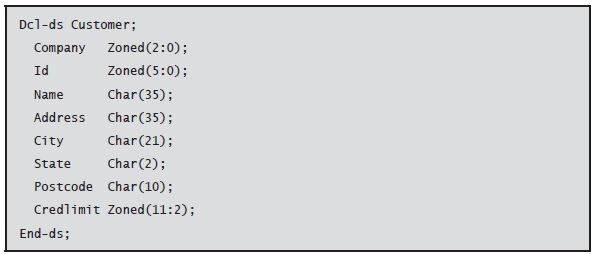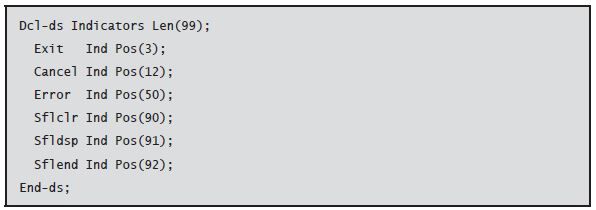In addition to named constants and standalone variables, you can define data structures, which are simply a means of organizing multiple variables within a single section of contiguous portions of memory. Miss the previous excerpts regarding using declarations? Read each here: Part 1 & Part 2 & Part 3
Editor's Note: This article is excerpted from chapter 4 of Programming in ILE RPG, Fifth Edition.
Data structures can provide flexibility in your handling of data by letting you group variables into a logical structure, subdivide variables into subfields, and redefine variables with different data types or names. An RPG program can process the entire data structure as a unit or its subfields individually.
RPG uses three instructions to declare data structures:
- Dcl-ds (Declare data structure)
- Dcl-subf (Declare subfield)
- End-ds (End data structure)
These instructions take the following form:
The following code illustrates a simple data structure definition:
The Dcl-ds (Declare data structure) instruction signals the beginning of a data structure. Following Dcl-ds, you can enter a name for the data structure, or you can use *N if the data structure is to be unnamed. The name is optional unless you plan to refer to the data structure as a whole elsewhere in your program. RPG treats named data structures as character strings, encompassing all their subfields. Data structure names follow the same rules as variable names.
Although you can enter the length of the entire data structure with the Dcl-ds instruction by using the Len keyword, Len is generally optional. If you omit it, the system derives the length of the structure as a whole from the lengths of its subfields. The maximum total length for a data structure is 16,773,104 bytes. You can also use the following Dcl-s instruction in the preceding example:
Defining Data Structure Subfields
The lines to describe subfields constituting the data structure follow the line with the Dcl- ds instruction. You define each subfield entry by giving it a name. It’s normal practice to indent the subfield definition to make the hierarchical layout of the data structure easily visible. The order of the subfields should represent their actual relative positions in the data structure. Following the subfield name, specify a data type keyword. Any data type allowed for standalone variables is also allowed for data structure subfields.
In the unlikely event that the subfield’s name is the same as an RPG operation code (e.g., Dow, Read, Write, Return), you must code a Dcl-subf (Declare subfield) instruction preceding the subfield name. Otherwise, you need not use Dcl-subf for a subfield declaration.
The data structure definition must accurately represent the locations of its subfields. Normally, each subfield immediately follows the preceding subfield in the data structure. Occasionally, your program will encounter a data structure that does not use all the locations in the data structure and will skip those unneeded locations. Usually, this occurs only with data structures that are predefined by an application or by IBM. In that case, use the Pos (Position) keyword to specify the beginning location for a subfield:
The position must be between 1 and the length of the data structure. This data structure is 99 bytes, but only positions, 3, 12, 50, 90, 91, and 92 are used—as named indicators in specific positions.
Initializing Data Structures
Once you have defined the data structure subfields, you can initialize them by using the Inz keyword. The Inz keyword initializes entire data structures or data structure subfields. If you code Inz (with no value following it) on the Dcl-ds instruction, the program initializes all the subfields in the data structure with initial values appropriate to the subfields’ data types. If you do not code Inz on the Dcl-ds instruction, the entire data structure, including all its subfields, is initialized with blanks—unless you code individual Inz keywords for specific subfields.
Data structures are considered character variables regardless of the data types of their subfields. As a result, they contain blanks at the start of your program unless you explicitly initialize their subfields. You initialize a data structure globally when you include the Inz keyword in the data structure header line. This use of Inz automatically initializes all subfields in the entire data structure.
Specifying Inz on the Dcl-ds instruction initializes all subfields to the default value appropriate for their data types (e.g., all numeric subfields are set to zero, all character fields to spaces):
Without the Inz keyword, all the subfields are initially blank. The program ends abnormally if you try to perform arithmetic operations on Areacode, Exchange, or Localnbr without first initializing them.
Alternatively, you can initialize specific subfields of a data structure by including the Inz keyword as part of their definitions. To initialize a subfield to a value other than the default, you can include the desired value within parentheses following Inz. Although you can express this value as a literal or a named constant, it must fit the subfield’s data type. Moreover, it cannot be longer than the subfield nor have more decimal positions than the subfield (if the type is numeric).
In this example, Areacode and Localnbr are initially zero, Exchange is 555, and Name is blank. You can also combine data structure initialization with individual subfield initialization to obtain the same result:
Next time: More Defining Data Structures. What to learn more now? Buy Programming in ILE RPG, Fifth Edition at the MC Press Bookstore today!


























 Business users want new applications now. Market and regulatory pressures require faster application updates and delivery into production. Your IBM i developers may be approaching retirement, and you see no sure way to fill their positions with experienced developers. In addition, you may be caught between maintaining your existing applications and the uncertainty of moving to something new.
Business users want new applications now. Market and regulatory pressures require faster application updates and delivery into production. Your IBM i developers may be approaching retirement, and you see no sure way to fill their positions with experienced developers. In addition, you may be caught between maintaining your existing applications and the uncertainty of moving to something new. IT managers hoping to find new IBM i talent are discovering that the pool of experienced RPG programmers and operators or administrators with intimate knowledge of the operating system and the applications that run on it is small. This begs the question: How will you manage the platform that supports such a big part of your business? This guide offers strategies and software suggestions to help you plan IT staffing and resources and smooth the transition after your AS/400 talent retires. Read on to learn:
IT managers hoping to find new IBM i talent are discovering that the pool of experienced RPG programmers and operators or administrators with intimate knowledge of the operating system and the applications that run on it is small. This begs the question: How will you manage the platform that supports such a big part of your business? This guide offers strategies and software suggestions to help you plan IT staffing and resources and smooth the transition after your AS/400 talent retires. Read on to learn:
LATEST COMMENTS
MC Press Online